Gujarat Board GSEB Solutions Class 8 Social Science Chapter 14 Introduction of the Continents: Africa and Asia Textbook Exercise Important Questions and Answers, Notes Pdf.
Gujarat Board Textbook Solutions Class 8 Social Science Chapter 14 Introduction of the Continents: Africa and Asia
GSEB Class 8 Social Science Introduction of the Continents: Africa and Asia Textbook Questions and Answers
Answer the following questions in short:
Question 1.
Which oceans lie to the north, south and east of the continent of Asia?
Answer:
Arctic Ocean lies to its north, Indian Ocean lies to its south and Pacific Ocean lies to the east of Asian Continent.
Question 2.
Why are the rivers that meet Arctic Ocean not useful as waterways ?
Answer:
The rivers like Ob, Yenisey and Lena which meet the Arctic Ocean remain frozen for most part of the year. So, they are not useful as waterways.
Collect information with the help of a physical map of Africa and fill it in the given columns A, B and C:
(The information is given here in the form of answer.)
| The Deserts ‘A’ | The Plains ‘B’ | The Highlands ‘C’ |
| Sahara | Plain of Siberia | Ethiopia |
| Kalahari | The plain of Sahel | Central |
| Libyan Desert | Plain of Euphrates-Tigris | |
| Nubian Desert | ||
| Namib Desert |
Study the political map of the world and fill in the blanks given below:
Question 1.
Write the names of any five countries of Asia that have a coastline ?
Answer:
Australia, Antarctica, North America and South America and India jointly, are the continents of the world that have a coastline.
![]()
Question 2.
In which direction of Asia do these continents lie? (Answers are given.)
Continent Direction from Asia
(1) Europe – to the north-west
(2) Africa – to the south-west
(3) Australia – to the south-east
Make a list of the fresh water lakhs of Asia and Africa
Answer:
1. Fresh water lakes of Asia : Baikal, Angara, Balkash, Tong Ting Hu, Tonlesap, Wular, Dal, Dhebar.
2. Fresh water lakes of Africa : Lake Victoria (largest), Lake Malawi (Nyasa), Lake Tanganyika.
Make a list of the countries of Asia with the help of the political map:
Answer:
Countries of Asia : India, Pakistan, Myanmar, Kazakhstan, Cambodia, China, Nepal, Sri Lanka, Bhutan, Maldives, Afghanistan, Iran, Iraq, UAE, Uzbekistan, etc.
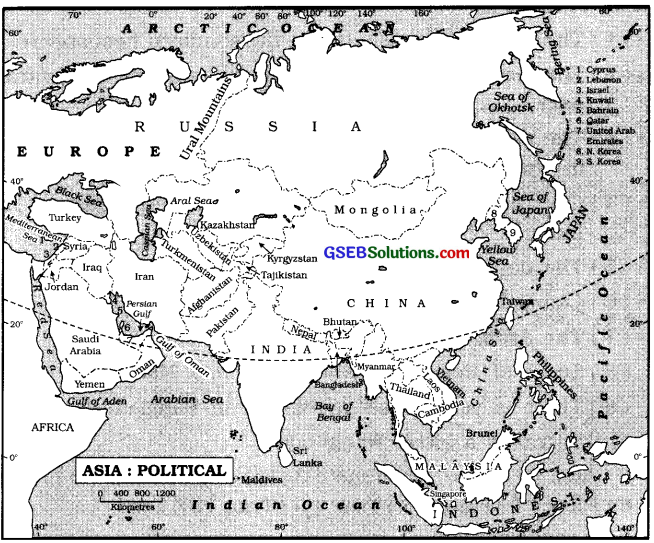
![]()
State whether the following statements are true or false:
1. The continent of Asia lies in the southern hemisphere.
Answer:
False
2. The temperature remains high in summer in Central
Asia.
Answer:
True
3. The winds blowing over the Arabian Sea bring rainfall in winter.
Answer:
False
4. Cherrapunji is located in the state of Assam in India.
Answer:
False
5. The Japanese live in tents made of leather.
Answer:
False
6. Camel is used for transportation in the Himalayas.
Answer:
False
![]()
7. The Arabs wear woolen clothes in summer.
Answer:
False
Identify me:
1. I live in the forests of Africa and Gir.
Answer:
Lion
2. I am a tree of the coastal region.
Answer:
Coconut
3. I am an animal useful for agriculture.
Answer:
Ox
4. I am the main tree of the equatorial region.
Answer:
Mahogany
![]()
Answer the following questions in short:
Question 1.
Name the hot and the cold deserts of Asia.
Answer:
The hot deserts of Asia are Arabia and Thar and the cold desert is Gobi.
Question 2.
Make a list of the neighbouring countries of India.
Answer:
Pakistan, Afghanistan, China, Nepal, Bhutan, Bangladesh and Myanmar are the neighbouring countries on the land borders of India, while, Sri Lanka and Maldives are other neighbouring countries situated in the Indian subcontinent.
Question 3.
Make a list of the housing styles of Asia which you like the most.
Answer:
There are various dwellings of Asia like: tents, huts, cement buildings with flat or sloping roofs, leather tents, houses made of wood, etc. Of these I like buildings of cement that have sloping roofs. I also like tents as they seem adventurous.
[Note: The answer can vary according to the student’s choice.]
Question 4.
Make a list of the animals found in Asia.
Answer:
Animals found in Asia : Reindeer, Polar, bears, tigers, wolves, panthers, lions, elephants, rhinoceros, camels, yak, muskrats, sables, raccoons, beavers, caribou, camels with two humps, horses, donkeys, mules, cows, oxen, buffaloes, sheep, goats, wildass, different types of deer, monkeys, etc. Different types of fish, seals, walruses and whales are found in the sea around it.
![]()
Activities
Make a list of the big cities of the countries of Africa and Asia on the basis of political maps of these countries.
GSEB Class 8 Social Science Introduction of the Continents: Africa and Asia Intext Questions and Answers
Question 1.
From which continent do the three major latitudes pass ?
Answer:
The three major latitudes, the Tropic of Cancer, the Equator and the Tropic of Capricorn all pass through the African continent.
Question 2.
Which strait separates the continents of Africa and Europe? See the map and write.
Answer:
The Strait of Gibraltar separates the continents of Africa and Europe.
Question 3.
Which region separates Asia and Africa? See the map and write.
Answer:
The Sinai Peninsula of Egypt separates Asia and Africa.
Question 4.
Which seas and oceans surround the continent of Africa? See the map and write.
Answer:
The Mediterranean Sea is to the north of Africa, the Red Sea is to its north-east, the Indian Ocean is to its east and the Atlantic Ocean is to its west.
Question 5.
Look at the map and locate the ‘Cape of Good Hope’.
Answer:
The ‘Cape of Good Hope’ is located to the extreme north-west of South Africa and on the coast of the Adantic Ocean.
![]()
Question 6.
With the help of the political map of Africa given above prepare a list of countries in it:
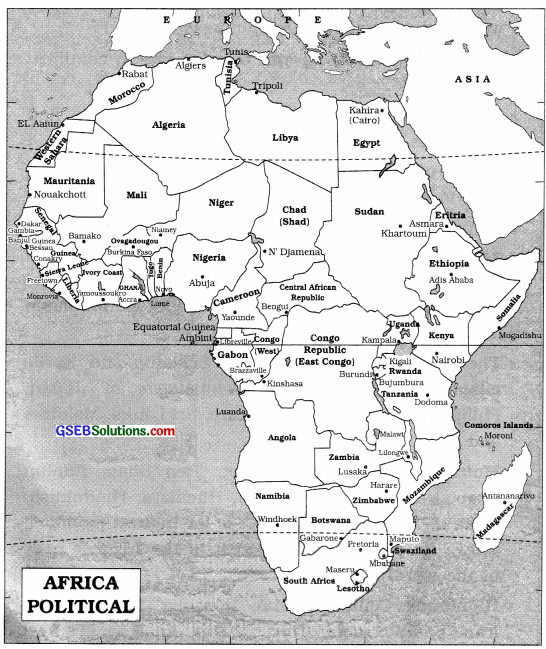
Question 7.
Fill in the blanks in the following tables by making use of physical map of Asia : (Answers are given in the form of fill ups.)
| Highlands | Plains | Island Groups |
| 1. Tibet | Siberia | Kuril Islands of Russia |
| 2. Indo-china | East China | Island Group of Japan |
| 3. India | Si Kiang | Philippines Islands |
| 4. Pamir | Mekong | Islands of Indonesia |
| 5. Iran | Irrawaddy | Andaman-Nicobar Islands |
| 6. Arabia | Sindhu-Ganga | Lakshadweep Islands |
| 7.Turkey (Anatolia) | Euphrates-Tigris | Maldives Islands |
![]()
Question 8.
Why can’t one drown in the Dead Sea ? Think and write.
Answer:
Dead Sea is the saltiest lake of the world. The salinity of its water is eight times, the average salinity of sea-water. Therefore, its water is very heavy. Its density is more than the density of a human body. Materials with less density than water do not sink in it but float upon it. According to this principle one can’t drown in the Dead Sea.
Question 9.
Think and say:
(1) Find out the places of Asia that receive the maximum and the minimum rainfall.
(2) Find out the places of Asia that experience maximum heat and maximum cold.
Answer:
(1) The places that receive the maximum rainfall in Asia are Mawsynram and Cherrapunji in the state of Meghalaya of India. The places that receive the minimum rainfall are the desert region of central and west Asia.
(2) The place that experiences the maximum heat is Jacobabad city of Pakistan and the place that experiences the maximum cold is Verkhoyansk city of Siberia.
Question 10.
Fill in the blanks in the following table with the help of map ’.(Blanks are filled up as answer,)
| River | Which sea does it flow into ? |
| 1. The Ganga | The Bay of Bengal in Indian Ocean |
| 2. The Lena | The Arctic Ocean |
| 3. The Tigris | The Indian Ocean |
| 4. The Sindhu | The Arabian Sea in Indian Ocean |
![]()
Question 11.
Pictures and names of some vegetation are given according to the vegetation regions as shown in the map of Asia. Write down the name of the natural vegetation region below that picture : (Names are written below in the form of answer.)
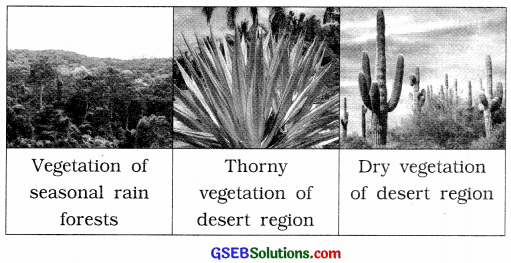
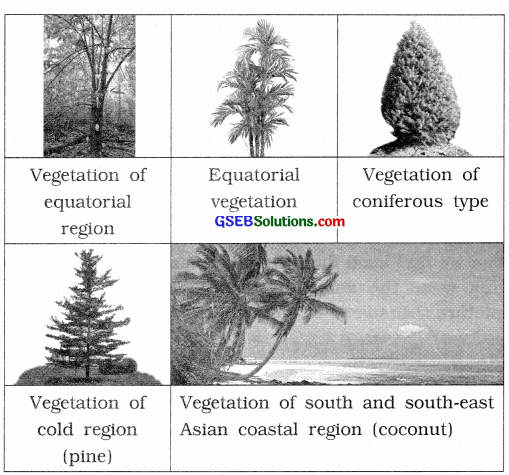
Question 12.
On page no. 119 of textbook pictures of people of Asia are given. Write down the names of the country in the box given below the picture, depending on the clothing of the people of the region, on the basis of map of Asia : (Answers are given below each picture.)
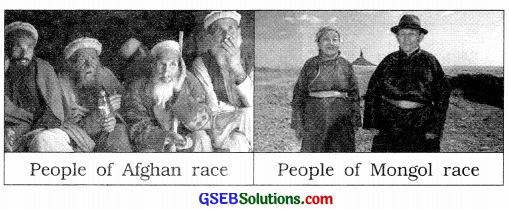
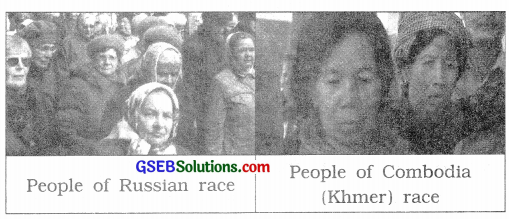
Question 13.
Find out from the map, in which areas of Asia can we find such dwelling places as shown in the pictures and write the name of that particular area below that picture: (Answers are given below each picture.)
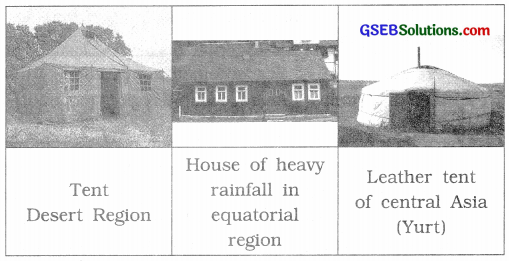
![]()
GSEB Class 8 Social Science Introduction of the Continents: Africa and Asia Additional Important Questions and Answers
Choose the correct alternative from those given below each question:
Question 1.
Which latitude divides Africa almost in two equal parts ?
A. The Tropic of Capricorn
B. The Antarctic Circle
C. The Tropic of Cancer
D. The Equator
Answer:
D. The Equator
Question 2.
In which year did Vasco-da-Gama discover the searoute to India from Europe ?
A. In 1502
B. In 1493
C. In 1498
D. In 1490
Answer:
C. In 1498
Question 3.
How much of the land portion of the world is covered by the African continent?
A. 30%
B. 25%
C. 20%
D. 23 %
Answer:
C. 20%
Question 4.
Africa is the …………………. largest continent of the world.
A. First
B. Second
C. Third
D. Fourth
Answer:
B. Second
Question 5.
What is the landform of Africa mostly made up of?
A. Plains
B. Deserts
C. Mountains
D. Highlands
Answer:
D. Highlands
![]()
Question 6.
Which is the highest mountain in Africa ?
A. Kilimanjaro
B. Atlas
C. Drakensberg
D. Kenya
Answer:
A. Kilimanjaro
Question 7.
Near which latitude is Kilimanjaro located ?
A. Near the Tropic of Cancer
B. Near the Equator
C. Near the Tropic of Capricorn
D. Near the Antarctic Circle
Answer:
B. Near the Equator
Question 8.
Which continent was known as the ‘Dark Continent’ till the end of 18th century ?
A. Africa
B. Antarctica
C. Australia
D. South America
Answer:
A. Africa
Question 9.
Which is the longest river of the world ?
A. Congo
B. Niger
C. Nile
D. Zambezi
Answer:
C. Nile
Question 10.
Which is the largest lake of Africa?
A. Chad
B. Victoria
C. Tanganyika
D. Malawi (Nyasa)
Answer:
B. Victoria
![]()
Question 11.
Which sweet water lake is the longest lake of the world ?
A. Superior
B. Michigan
C. Baikal
D. Tanganyika
Answer:
D. Tanganyika
Question 12.
When does it rain in areas that enjoy the Mediterranean type of climate ?
A. Round the year
B. In summer
C. In winter
D. In spring
Answer:
C. In winter
Question 13.
On which African river are the world famous Victoria Falls located ?
A. Nile
B. Zambezi
C. Niger
D. Congo
Answer:
B. Zambezi
Question 14.
Which African island is called the ‘Island of Cloves’ ?
A. Zanzibar
B. Madagascar
C. Mauritius
D. Canary
Answer:
A. Zanzibar
Question 15.
Which is the main crop of Egypt?
A. Jute
B. Sugarcane
C. Cotton
D. Tobacco
Answer:
C. Cotton
![]()
Question 16.
Which is the capital of South Africa?
A. Cape Town
B. Pretoria
C. Johannesburg
D. Durban
Answer:
B. Pretoria
Question 17.
Which is the largest continent of the world from population and area point of view?
A. Asia
B. Africa
C. North America
D. Europe
Answer:
A. Asia
Question 18.
How many percent of the population of the world lives approximately in Asia?
A. 30 %
B. 40 %
C. 45 %
D. 50 %
Answer:
D. 50 %
Question 19.
How many percent of land portion of Asia is approximately that of the world ?
A. 20 %
B. 25 %
C. 30 %
D. 35 %
Answer:
C. 30 %
Question 20.
Which mountain of Asia is the highest mountain of the world ?
A. Himalayas
B. Kunlun Shan
C. Altai
D. Hindukush
Answer:
A. Himalayas
![]()
Question 21.
Which highland of Asia is the highest and the largest highland of the world ?
A. Mongolia
B. Siberia
C. Iran
D. Tibet
Answer:
D. Tibet
Question 22.
Which city experiences the highest cold in the world ?
A. Moscow
B. Chicago
C. Verkhoyansk
D. Stockholm
Answer:
C. Verkhoyansk
Question 23.
Which is the longest river of Asia ?
A. Yangtze
B. Hwang Ho
C. Lena
D. Sindhu
Answer:
A. Yangtze
Question 24.
Which of the following is the largest lake of the world ?
A. Caspian Sea
B. Aral Sea
C. Victoria lake
D. Baikal lake
Answer:
A. Caspian Sea
Question 25.
Which is the deepest lake of the world in Asia ?
A. Aral
B. Balkash
C. Baikal
D. Tonlesap
Answer:
C. Baikal
![]()
Question 26.
Which of the following lakes has the highest salinity?
A. Caspian Sea
B. Dead Sea
C. Sambhar
D. Aral Sea
Answer:
B. Dead Sea
Question 27.
In which country is Khyber Pass situated ?
A. Pakistan
B. India
C. Iran
D. Afghanistan
Answer:
A. Pakistan
Question 28.
In which country are the internal waterways found in large numbers ?
A. Sri Lanka
B. Nepal
C. Bhutan
D. Bangladesh
Answer:
D. Bangladesh
Question 29.
From which of the following neighbouring countries does India import mineral oil ?
A. Pakistan
B. Bangladesh
C. Myanmar
D. Sri Lanka
Answer:
C. Myanmar
Question 30.
Of which country is yak the special animal?
A. Pakistan
B. Bhutan
C. Bangladesh
D. Sri Lanka
Answer:
B. Bhutan
![]()
Fill in the blanks with proper words or figures in the following statements:
1. The ……………… Strait separates Africa and Europe.
Answer:
Mediterranean
2. The ……………… Sea located to the North-east of Africa separates Africa and Asia.
Answer:
Red
3. The ………………. Ocean is to the east of Africa.
Answer:
Indian
4. The ………………. Ocean is to the west of Africa.
Answer:
Atlantic
5. Africa possesses approximately …………………. thousand kilometres long coastline.
Answer:
thirty
6. The highest mountain ……………….. is situated to the northwest of Africa and it has a height of metres.
Answer:
Toubkal; 4165
![]()
7. The highland of ………………. with altitude between 1500 and 4550 metres is the highest highland in Africa.
Answer:
Ethiopia
8. The River Nile is ……………… kilometres long.
Answer:
6436
9. ………………. country is known for its ancient pyramid and sphinx.
Answer:
Egypt
10. Europe and Asia have come closer due to the ………………. Canal of Egypt.
Answer:
Suez
11. ……………….. is the capital and an industrial city of Egypt.
Answer:
Cairo (Kahira)
![]()
12. Rich mines of ……………….. and ………………. are found in the Vaal river region of South Africa.
Answer:
gold; diamond
13. The most developed country of the African continent is ………………. .
Answer:
South Africa
14. ……………….. highland is known as the ‘Roof of the World’.
Answer:
Tibet
15. Maximum rainfall occurs in …………….. and ……………… of India in Asia.
Answer:
Mawsynram, Cherrapunji
16. Maximum heat falls in …………………… city of Pakistan of Asia in summer.
Answer:
Jacobabad
17. …………………. country was called as the ‘The Land of Thunder Dragon’ by the British.
Answer:
Bhutan
![]()
18. The most important crop of Pakistan is ………………. .
Answer:
Cotton
19. Agricultural revolution has taken place in Pakistan due to water of river ……………… .
Answer:
Sindhu
20. ……………….. % of area of Nepal is covered with forest.
Answer:
40%
21. Only ………………… % of land of Nepal is worth farming.
Answer:
16%
22. People of Bhutan mainly practice ……………… .
Answer:
Buddhism
23. Strait of ………………. and Gulf of ………………. are separate India and Sri Lanka.
Answer:
Palk, Mannar
![]()
24. The name of the largest river of Sri Lanka is ……………….. .
Answer:
Mahaweli Ganga
25. The capital city of Myanmar is ………………. .
Answer:
Naypyidaw
State whether the following statements are true or false:
1. \(\frac { 2}{ 3 }\)rd part of the African continent lies in northern hemisphere.
Answer:
True
2. The Equator divides the African continent into almost two equal parts.
Answer:
False
3. Most of Africa lies in the Torrid zone.
Answer:
True
4 There are 53 countries in the African continent.
Answer:
True
5. The Congo River is the longest river of Africa.
Answer:
False
![]()
6. The magnificent culture of Egypt has developed on the banks of the river Nile.
Answer:
True
7. Strait of Bering separates Asia and North America.
Answer:
True
8. There is very dense population in Bangladesh.
Answer:
True
9. Baikal is a sweet water lake.
Answer:
True
Match the pairs correctly:
1.
| Section ‘A’ | Section ‘B’ |
| (1) Victoria | (1) Highland |
| (2) Atlas | (2) River |
| (3) Ethiopia | (3) Falls |
| (4) Niger | (4) City |
| (5) Mountain |
Answer:
(1 – 3), (2 – 5), (3 – 1), (4 – 2).
![]()
2.
| Section ‘A’ | Section ‘B’ (Community of people) |
| (1) Banks of river Congo | (1) Bushmen |
| (2) Kalahari desert | (2) Bedouins |
| (3) Kenya | (3) Hausa |
| (4) Egypt | (4) Pygmy |
| (5) Bantu |
Answer:
(1 – 4), (2 – 1), (3 – 5), (4 – 2).
3.
| Section ‘A’ (Country) | Section ‘B’ (Capital) |
| (1) Pakistan | (1) Thimphu |
| (2) Sri Lanka | (2) Islamabad |
| (3) Bhutan | (3) Dhaka |
| (4) Bangladesh | (4) Colombo |
| (5) Yangon |
Answer:
(1 – 2), (2 – 4), (3 – 1), (4 – 3).
Identify me :
1. I am the country in central Himalayas.
Answer:
Nepal
2. I am known as ‘Ratnadweep’.
Answer:
Sri Lanka
![]()
3. I am the main river of Pakistan.
Answer:
Sindhu
4. I am the large and cold desert of Asia.
Answer:
Gobi
Answer the following questions in one or two sentences each:
Question 1.
Which mountain ranges are situated to the north west of Africa?
Answer:
The Atlas mountain ranges are situated to the north-west of Africa.
Question 2.
Why do the peaks of Kilimanjaro always remain covered with snow though it is situated near the equator ?
Answer:
The height of Kilimanjaro is 5895 metres. Owing to its great altitude its peaks always remain covered with snow even though it is situated near the equator.
Question 3.
Through which countries does the river Nile flow and which sea does it meet?
Answer:
The River Nile flows through Uganda, Sudan and Egypt countries. Blue Nile, which is its main tributary flows from Ethiopia and meets it near Khartoum in Sudan. The joint flow of both the rivers flows through Sudan and Egypt to meet the Mediterranean Sea.
![]()
Question 4.
What type of climate is found in the equatorial forest region?
Answer:
The climate of the equatorial forest region is extremely hot and humid. It rains here round the year.
Question 5.
Which kind of vegetation is seen in the Sahara desert region?
Answer:
Scattered thorny vegetation like cactus, jujube tree, date palm, etc. is seen in the Sahara desert region.
Question 6.
By what name are the grasslands of Africa known ?
Answer:
The grasslands of Africa are known as ‘Savannah’.
Question 7.
Which crops are grown in Africa along with other regular crops like cereals and pulses ?
Answer:
Various crops like tea, coffee, cocoa, rubber, tobacco, sugarcane, clove, a variety of tuberous roots and vegetables, fruits, oilseeds, etc. are grown in Africa along with regular crops like cereals and pulses.
![]()
Question 8.
Name the following with reference to Africa: (Names are given as answers.)
(1) Main lakes formed in the large Rift Valley: Tanganyika, Malawi (Nyasa), Turkana (Rudolph).
(2) Four main rivers : Nile, Congo, Niger, Zambezi.
(3) Main lakes : Victoria, Tanganyika, Malawi (Nyasa), Chad, Turkana (Rudolph).
(4) Important trees of the equatorial forest: Mahogany, ebony, logwood, rosewood, ironwood, rubber, cinchona, bamboo, etc.
(5) Fruits of Mediterranean climate region : Oranges, lemons, peaches, grapes, etc.
(6) Main animals : Lions, leopards, panthers, elephants, rhinoceroses, giraffes, zebras, hippopotamuses, gorillas, chimpanzees, a variety of monkeys and deer, ostriches, crocodiles, camels, cows, horses, donkeys, sheep and goats, a variety of birds, etc.
(7) Main minerals : Gold, diamond, copper, manganese, uranium, etc.
(8) Mineral oil possessing countries : Libya, Egypt.
Answer the following questions:
Question 1.
Give brief information about the location and area of the African continent.
Answer:
- Africa is the second largest continent of the world.
- The length and breadth of the African continent is almost the same.
- Most of the continent i.e. \(\frac { 2 }{ 3 }\)rd lies north to the Equator.
- The Tropic of Cancer passes through the north and the Tropic of Capricorn passes through the south, so most of Africa is in the Torrid Zone.
- Most of Africa lies in the Eastern hemisphere.
- It covers 20 % of the total land mass of Earth and has a 30,000-km long running coastline.
Question 2.
Give some information about on the landform of Africa.
Answer:
- Plateaus and Highlands : The major landform of Africa is plateaus and highlands. The Ethiopian highlands have an altitude between 1500 and 4500 metres. There are highlands and plateaus that have an average altitude of 915 metres in South Africa.
- Mountain Ranges : Atlas Mountain Ranges lie in the north-west of Africa. Mount Toubkal (4165 metres) is the highest peak. Mt. Kilimanjaro is the highest volcanic mountain in the mountain range of East Africa. Its height is 5895 metres.
- Desert: The huge Sahara Desert, the largest and hottest desert of the world lies in the north of Africa and covers an area of 9,400,000 sq km. It is full of rocky highlands.
- Rift Valley: The Great Rift Valley of East Africa (the longest one of the world) was created due to tectonic movements and it runs north- south for approximately 6000 km. Lakes Tanganyika, Malawi (Nyasa), etc. lakes have been formed due to accumulation of water.
![]()
Question 3.
Write short note on the main rivers and lakes of Africa.
Answer:
Rivers : The main rivers of Africa are Nile, Congo, Niger and Zambezi. Most of Africa’s rivers originate from the central highlands and meet the sea. They are not useful as waterways, but various waterfalls created due to the rugged terrain help in producing hydroelectricity. The Nile is the longest river of the world. Its length is 6436 km. It originates in the highlands of Ethiopia and flows through Sudan and Egypt to meet the Mediterranean Sea. The Victoria Falls located on river Zambezi are world famous.
Lakes: Victoria, Malawi (Nyasa), Tanganyika, Chad, Turkana (Rudolph), etc. are the main lakes. Victoria, Africa’s biggest lake, is the largest tropical lake and the second largest freshwater lake in the world. Lake Tanganyika is the longest sweet water lake in the world.
Question 4.
Give brief information about climate and vegetation of Africa.
Answer:
- The climate of Africa is diverse. Varying temperature and precipitation leads to a wide variety of vegetation. The extremely hot and humid climate suits the Equatorial rain forests and trees like mahogany, ebony, logwood, rosewood, ironwood, rubber, cinchona and bamboo flourish here.
- Rainfall decreases as one proceeds due north. So, vegetation also changes from Savannah grass lands to thorny vegetation, like cactus, jujube tree, date palm, etc. in the Sahara desert.
- The Mediterranean region of Africa receives rainfall in winters also. Sweet fruits like grapes, peaches, etc. and citrus fruits like oranges, lemons, etc. are grown here.
- Almost 70 % of Africans are agriculturists. Crops like tea, coffee, cocoa, rubber, tobacco, etc. are grown here. Crops like cloves, rice, etc. are also grown here. Zanzibar is known as the ‘Island of Cloves.’
Question 5.
State in brief the location and area of the Asian continent.
Answer:
- Location s Between 10° 16′ S. latitude to 77° 43’ N. latitude and 26° 04′ E. longitude to 169° 40′ W, longitude. (Note: The underlined words are printed wrongly In the textbook)
- Boundaries : The Indian Ocean to the south of Asia, the Pacific Ocean to the east, the Arctic Ocean to its north, Europe to its north-west, Africa to its south-west and Australia to its south-east.
- The Strait of Bering separates Asia and North America. At the border between Asia and Europe lie the Ural Mountains, the Caspian Sea, the Caucasus Mountain and the Black Sea.
- Area : 4,45,79,000 sq km. It is the largest continent of the world.
Question 6.
Give brief information of Landform of Asia.
Answer:
On the landform of the Asian continent, mountains, highlands, plains and deserts are situated.
(1) Mountains : Altai, Pamir Knot, Tien Shan, Kunlun Shan, Nan Shan, Karakoram, Himalaya, Hindukush, Elburz, Zagros, etc. are the main mountains of Asia. Himalaya is the highest mountain range of all. Its peak Mount Everest is the highest peak of the world (8848 metres).
(2) Highlands : Central Siberia, Mongolia, Tarim, Turan, Iran, Saudi Arabia, Tibet, Yunan, Anatolia (Turkey) and highlands of Southern India are the main highlands of Asia. Among these, the highland of Tibet is the largest and the highest. So, it is called the ‘Roof of the World’.
(3) Plains : Plains of West Siberia, Manchuria, Hwang Ho and Yangtse of East China, Mekong, Irrawaddy, Brahmaputra, Ganga, Sindhu and Euphrates-Tigris are the main plains of Asia. The plains of East China and Sindhu-Ganga have dense population.
(4) Deserts : The hot deserts of Arabia and Thar and cold desert of Gobi are the main deserts of Asia.
![]()
Question 7.
Write a short note on climate of Asia.
Answer:
As Asia is a very large continent, a variety of climate is seen in different regions :
- The climate of the Equatorial regions of south-east Asia is hot and humid. It rains here round the year.
- In the seasonal climate region to its north, the overall climate is hot and dry. Here mainly the seasonal winds of summer bring rain. Mawsynram and Cherrapunji of India in this region, receive the highest rainfall in the world.
- To the west of this region and in Central parts of Asia, there is mainly desert type of climate. Rainfall is very scanty here. There is maximum heat in Jacobabad city of Pakistan in Asia.
- The climate of Siberia, which is located to the extreme north of Asia, is extremely cold. The Verkhoyansk city of this region is the coldest city of the world.
- There is rainfall in summer in East and South Asia, while, there is rainfall in winter in the regions located on the coast of the Mediterranean Sea in West Asia.
Question 8.
Write in brief about the Rivers of Asia.
Answer:
- The main rivers of North Asia which meet the Arctic Ocean are Ob, Yenisey and Lena of Siberia. These rivers remain frozen for most part of the year and so cannot be used as water routes.
- Big rivers like Amur, Hwang Ho, Yangtze Si Kiang and Mekong meet the Pacific Ocean. Yangtze river is the longest river of Asia.
- Big rivers like Irrawaddy, Salvin, Ganga, Godavari, Krishna, Kaveri, Narmada, Sindhu, Euphrates-Tigris meet the Indian Ocean.
- Inland rivers Amudariya and Sirdariya meet the Aral Sea.
Question 9.
Give brief information about the lakes of Asia.
Answer:
- Caspian Sea, Aral Sea, Dead Sea and Sambhar, Chilka, Pulicat and Vembanad lakes of India are the main salt water lakes of Asia.
- Baikal and Angara of Russia, Balkash of Kazakhstan, Tong Ting Hu (Tung Ting Hu) of China, Tonlesap of Cambodia and Wular, Dal and Dhebar lakes of India are fresh water lakes.
- Caspian Sea is the biggest lake of the world.
- Baikal lake is the deepest lake of the world.
- The Dead Sea located between Israel and Jordan is the saltiest lake of the world. The salinity of this lake is eight times that of sea water. It is the lowest place in the world. Its level is approximately 400 metres lower than sea level. As a result one cannot drown in the Dead Sea.
![]()
Question 10.
State in brief. Which types of vegetation are found in Asia ?
Answer:
- In the Equatorial forests of Asia, trees like mahogany, ebony, logwood, rosewood, ironwood, rubber, cinchona and bamboo are found.
- In humid deciduous forests regions of seasonal rain trees like teak, saal, sandalwood, mahudo, mango tree, etc. are found.
- In dry scrub forests (semi-arid regions), thorny vegetations like grass, aloevera, acacia, cactus, jujube, date palm are found.
- In the steppes region main vegetation is the tender grass of low height.
- In coniferous forests to the north of the steppe region trees like pine, fir, spruce, etc. are found.
- To the extreme north, vegetation of Tundra region is seen.
- Olive is the main tree of Mediterranean Sea climate.
- Coconut tree is the main tree of the coasted region of high rainfall in Torrid zone.
Question 11.
Write short note on the animals found in different regions of Asia.
Answer:
- Reindeer and dogs are animals that are found and can be tamed, in very cold regions of Siberia. Moreover, Polar bears, wolves, muskrat, sable, raccoon, beaver and caribou are main wild animals.
- Horses, camels with two humps, sheep and goats are reared in the central region of Asia. The camel is very useful in desert region.
- Camels, horses, donkeys and mules Eire the mainly domesticated animals of West Asia.
- In the forests of east, south and south-east Asia tigers, panthers, wolves, elephants, rhinoceroses, a variety of monkeys, etc. Eire seen. Lions live only in the Gir forest. Wildass are seen in the desert of Kachchh and yak are found in the Himalayan region. Cows, oxen, buffEiloes, camels, horses, donkeys, sheep, goats and yak are domestic animals of this region.
- In the cold sea regions different types of fish, seals, walruses and whales are seen.
Question 12.
State in brief the specialities of food of people of different regions of Asia.
Answer:
- People of very cold regions of North Asia mainly live on non-vegetarian food, as it is impossible to do farming here.
- People of West Asia use wheat, meat, fish Eind date palm as their food.
- In agricultural regions with heavy rainfall and seasonal climate, people use rice, wheat, pulses, vegetables, fruits Eind milk as their food. The staple food of people of the coastal areas of this region is rice and fish.
- The staple food of east and south-east Asian countries, India and Sri Lanka, is rice.
![]()
Question 13.
Give brief information about the various housing of the people of Asia.
Answer:
- Wood is mainly used for construction of residences in the cold regions of Asia.
- People of nomadic tribes in Central Asia who rear animals use tents.
- People having permanent residences stay in huts, buildings of clay or bricks and stones or in multistoried buildings depending on their economic condition.
- In hot regions, receiving scanty rainfall, there are terraces on buildings or clay tiles on roof tops. The regions with heavy rainfall buildings with slanting roof tops are seen. In regions with snowfall, the roof tops are made with extreme slopes so that, snow can quickly slide down without getting deposited on the roof tops.
- In countries like Japan that has frequent earthquakes, houses are constructed from hardboard, plywood, bamboo and cardboard.
Question 14.
Make a list of (only names): (Answers are given.)
1. Three large rivers of Asia meeting the Arctic Ocean : Ob, Yenisey, Lena.
2. Five large rivers of Asia meeting the Pacific Ocean: Amur, Hwang Ho, Yangtze, Si Kiang, Mekong.
3. Large rivers of Asia meeting the Indian Ocean: Irrawaddy, Ganga, Godavari, Krishna, Kaveri, Narmada, Sindhu, Euphrates-Tigris.
4. Two large inland rivers meeting the Aral Sea: Sirdariya, Amudariya.
5. Salt water lakes of Asia : Caspian Sea, Aral Sea, Dead Sea, Chilka, Pulicat, Vembanad, Sambhar.
6. Three wonders of the world that are in Asia : Taj Mahal, Great wall of China, Burz Khalifa.
Answer the following questions in brief:
Question 1.
Why do people of North Asia take only nonvegetarian food ?
Answer:
The winter in North Asia is very long and extremely cold. In the extreme part of North, the land remains covered with snow for eight to ten months of the year. Summer is also very short and overall cold. In this situation farming is not possible here at all. So, the people of North Asia have to eat only non-vegetarian food.
Question 2.
State the main food of people of West Asia.
Answer:
The people of West Asia mainly use wheat, meat, fish and date palms as their food.
![]()
Question 3.
Which items are mainly included in the food of people of coastal regions of East and South Asia?
Answer:
Rice, fish and coconut are the main food items that people of coastal regions of East and South Asia consume.
Question 4.
State special features of the residences of cold regions of Asia.
Answer:
Wood is mainly used for the construction of residences in cold regions of Asia. Wood is available in sufficient amount in coniferous forests here. Glass windows are placed in the south direction of the buildings, so that sunlight can be available in sufficient amount in the residences here.
Question 5.
Why do the Japanese stay in houses built of plywood, hardboard, bamboo and cardboard?
Answer:
Buildings collapse in severe earthquakes. People can get buried under the debris of buildings, which mainly comprises of heavy materials like bricks and stones, etc. Japan is a country of earthquakes. Here earthquakes occur frequently. Should such heavy building materials be used there would certainly be heavy casualties. To avoid this, people of Japan, make houses of plywood, hardboard, bamboo and cardboard which are very light in weight.
Give brief introduction of the following countries:
Question 1.
(1) Egypt
(2) South Africa
Answer:
(1) Egypt: Egypt is one of the most ancient countries. It is an Arab Republic. This great civilization developed on the banks of river Nile. This country is famous for its pyramids and Sphinx. The Tropic of Cancer passes through the south of Egypt. Dates and cotton are grown in abundance here. Cairo (Kahira) is the capital city of the country as well as the industrial city. The Suez Canal has brought Europe and Asia closer to each other. The Bedouin tribe lives in Egypt. Nile, the longest river of the world originates in the highlands of Ethiopia and flows through Sudan and Egypt to meet the Mediterranean Sea. Mineral oil is found in Libya and Egypt.
(2) South Africa : Located at the southernmost end of Africa, South Africa lies in the temperate zone and has a temperate climate. It was primarily an agricultural country but the discovery of diamond and gold mines near river Vaal in 1867 changed its economy drastically. The capital is Pretoria but the Parliament is in Cape Town. Johannesburg and Durban are the other main cities. There are highlands and plateaus that have an average altitude of 915 metres in South Africa. Minerals like gold, copper, uranium, manganese, etc. are found in mines at Johannesburg and Transvaal regions of South Africa.
![]()
Question 2.
(1) Pakistan
(2) Bangladesh
(3) Sri Lanka
Answer:
(1) Pakistan : Declared itself an ‘Islamic Nation’ on attaining independence along with India; Capital: Islamabad. Khyber Pass located in the Hindukush Range is in Pakistan. The Green revolution has been possible due to the perennial River Sindhu. Main crop : Cotton.
(2) Bangladesh: A densely populated country with major delta portion of Ganga and Brahmaputra rivers; Main rivers : Padma (Ganga), Jamuna (Brahmaputra) and Meghna; Main crops: Paddy and jute cultivated in abundance; good development of waterways; Capital: Dhaka famous for its jute industry.
(3) Sri Lanka : The island country which was known as Ceylon or Sinhaldweep in the past. It is also known as ‘Ratnadweep’ or ‘Pearl of the Indian Ocean’. The Palk Strait in the north and the Gulf of Mannar in the west separate it from mainland India; Capital: Colombo. This small island country has more than 104 rivers. Biggest river : Mahavelli; Climate : Hot and humid due to being near the Equator. Main crops: Paddy, tea, coconut, spices and rubber; Main languages : Sinhalese and Tamil.